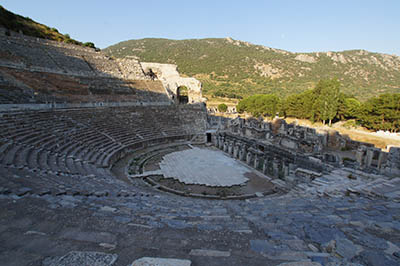Biblical Riot at Ephesus: The Archaeological , province of Asia in modern-day Turkey
Archaeology shines light on the riot against Paul at Ephesus WM
In Acts 19, Luke describes a frenzied riot at Ephesus, a city in the Roman province of Asia in modern-day Turkey:
biblical Archaeology Society Staff • 07/14/2016
About that time no little disturbance broke out concerning the Way. A man named Demetrius, a silversmith who made silver shrines of Artemis, brought no little business to the artisans. These he gathered together, with the workers of the same trade, and said, “Men, you know that we get our wealth from this business. You also see and hear that not only in Ephesus but in almost the whole of Asia this Paul has persuaded and drawn away a considerable number of people by saying that gods made with hands are not gods. And there is danger not only that this trade of ours may come into disrepute but also that the temple of the great goddess Artemis will be scorned, and she will be deprived of her majesty that brought all Asia and the world to worship her.”
When they heard this, they were enraged and shouted, “Great is Artemis of the Ephesians!” The city was filled with the confusion; and people rushed together to the theater, dragging with them Gaius and Aristarchus, Macedonians who were Paul’s travel companions. Paul wished to go into the crowd, but the disciples would not let him; even some officials of the province of Asia, who were friendly to him, sent him a message urging him not to venture into the theater. (Acts 19:23–31)
According to Acts, the riot would have occurred at the end of the missionary visit of Paul at Ephesus (around 55 or 56 C.E.). How accurate is Luke’s description of Ephesus at this time? In “Archaeology Gives New Reality to Paul’s Ephesus Riot” in the July/August 2016 issue of Biblical Archaeology Review, James R. Edwards, the Bruner-Welch Professor Emeritus of Theology at Whitworth University, describes how archaeological evidence fills in the historical context for Luke’s account of the riot at Ephesus.
In the Roman period, Ephesus was an important commercial center. Excavations conducted by the Austrian Archaeological Institute since 1895 have shown that the ancient city—which rivaled Antioch as the third-largest city of the Roman world—boasted a harbor, various civic structures, bath complexes, a theater and the Temple of Artemis, one of the Seven Wonders of the Ancient World.
In the Roman period, Ephesus was an important commercial center. Excavations conducted by the Austrian Archaeological Institute since 1895 have shown that the ancient city—which rivaled Antioch as the third-largest city of the Roman world—boasted a harbor, various civic structures, bath complexes, a theater and the Temple of Artemis, one of the Seven Wonders of the Ancient World.
Four times the size of the Athenian Parthenon, the famous Temple of Artemis had 127 gleaming marble columns that stood 60 feet tall and were topped with Ionic capitals. It was the Temple of Artemis, the silversmith Demetrius argued in Acts 19, that was being threatened by “the Way” (the early Christian movement) and Paul’s missionary effort. In saying that “gods made with hands are not gods” (Acts 19:27), Demetrius alleged, Paul was harming the silversmith industry that made little shrines used as dedicatory offerings to Artemis and tarnishing the reputation of the Artemis cult at Ephesus. However, a 16-line Greek inscription discovered during excavations showed that a century after the mission of Paul at Ephesus, in the late second or early third century, the silversmith trade and the cult of Artemis were still thriving.
When the anger that Demetrius incited reached a fever pitch, the rioters were said to have rushed into the city’s theater, dragging in Paul’s travel companions Gaius and Aristarchus. Excavations have uncovered the theater, which is set into a steep hillside at Ephesus. Massive in scale, the semicircular Roman theater held 25,000 seats and was one of the largest in the ancient world.
According to BAR author James R. Edwards, Luke’s account of the riot at Ephesus in Acts “contains a wealth of historical detail, some of which—proconsuls, standing courts and a city secretary—were common throughout the Roman Empire. But many more details—the immense temple commemorating the Artemis cult, the Artemis figure peculiar to Ephesus who was believed to have ‘fallen from heaven’ (Acts 19:35), guilds of silversmiths, Asiarchs and the city of Ephesus itself: its greatness, its theater and its honor as neōkoros, ‘temple guardian’—all are unique to Ephesus and the Roman province of Asia.”
In the free eBook Paul: Jewish Law and Early Christianity, learn about the cultural contexts for the theology of Paul and how Jewish traditions and law extended into early Christianity through Paul’s dual roles as a Christian missionary and a Pharisee.
To the right, one can see the single column that remains from the Temple of Artemis at Ephesus. Considered one of the Seven Wonders of the Ancient World, the massive temple was the largest building in the Hellenistic world. Photo: Jordan Pickett.
The so-called Beautiful Artemis statue was one of four statues of Artemis excavated at Ephesus in 1956. Measuring 5.7 feet tall, the statue dates to the Hadrianic–early Antonine periods (c. 117–150 C.E.). On either side of Artemis are female deer, and the zodiac signs appear on her upper chest. Rows of oval pendants—possibly representing bulls’ scrota—hang from her chest. These attributes, according to BAR author James R. Edwards, may represent “Artemis’s ultimate trophies in taming and subjugating the quintessential symbols of virility.” According to the silversmith Demetrius in Acts 19, the mission of Paul at Ephesus threatened the reputation of Artemis’s cult. Photo: Jordan Pickett.
This Roman theater played an important role in the riot at Ephesus against Paul and the early Christians, according to Luke’s account in Acts 19. Photo: Jordan Pickett.





Comments
Post a Comment